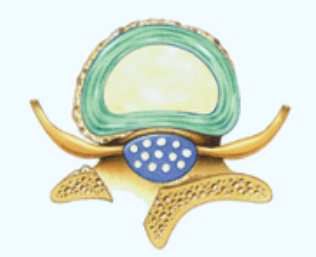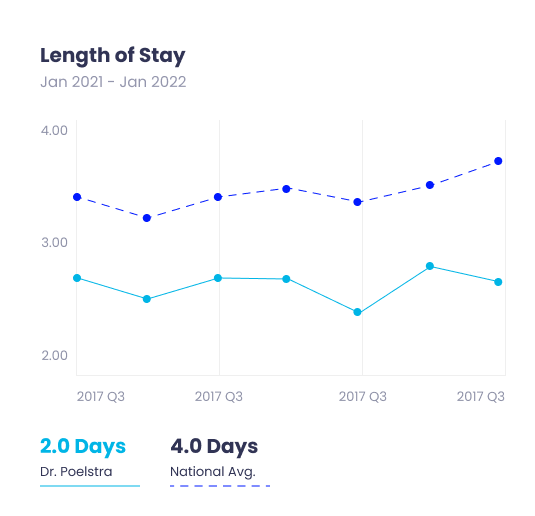Spinal Conditions
Our Conditions
Home>Conditions
The lumbar spine consists of the bony vertebrae, discs, nerve roots and other structures. The vertebrae, which stack up to create the spinal column, surround and protect the spinal cord and, in the lumbar spine, the nerve roots (called the cauda equina). The nerve roots travel out small bony windows (foramenae). The discs are located between each vertebra. Discs consist of a fibrous outer layer (annulus) surrounding a gelatinous center (nucleus). They allow motion between vertebrae, act as shock absorbers, and distribute the stress and strain placed on the spine.


As we age, normal degenerative changes occur which can include the development of bone spurs, small cysts, and thickening of ligaments. This can cause narrowing (stenosis) and apply pressure on the nerve roots. This is experienced as pain which radiates down the thigh and/or leg with walking or standing (neurogenic claudication). If the pressure on the spinal nerve roots continues, numbness or muscle weakness in the leg or foot may develop. Most patients with stenosis do not experience these symptoms. Some people, though, may require surgery. There are rare circumstances in which patients require immediate surgery. These include cauda equina syndrome and/or progressive neurologic loss (increasing weakness). Symptoms of cauda equina syndrome may include changes in bowel or bladder function, numbness or change in sensation in the area around the buttocks, genitalia, or thigh, and weakness and/or radiating numbness in the legs. People who develop symptoms of cauda equina syndrome should seek medical attention immediately.
Conservative Management: With time, inflammation around the nerve roots can go away on its own. Steroid injections may help relieve the pain and some of the inflammation around the nerve roots. If these attempts at conservative care do not relieve symptoms or if there is progressive neurological damage however; surgery may be necessary.
Microdecompression: is an operation to remove pressure on a nerve caused by spinal stenosis. This surgery involves a vertical incision one to two inches in length along the midline of the back. The doctor uses a microscope to see and protect the nerve roots, and safely remove the portions of tissue and bone which press on the nerve roots. Removing the tissues pressing on the nerve allows the nerve to begin to heal.


The reason to do this surgery is to relieve the leg pain or weakness caused by the pressure on the nerve roots. The success rate of relieving leg pain is very high, approximately 90%. The success rate of relieving chronic back pain present prior to surgery is much less predictable. The length of the operation is typically short (60-90 minutes), but depends on the number of spinal levels operated upon, whether or not previous surgery has been performed and the severity of the pressure on the nerve roots. Blood loss is minimal so no blood donations are necessary before the operation. Hospitalization is brief and while some patients may go home the day of surgery, most patients go home the day after surgery.
Surgery and anaesthesia involve stresses to many organs and tissues in the body. Incisions and handling tissues during surgery can result in many problems. The benefits of surgery must be carefully weighed against these risks. Some more common or serious problems are listed here.
Recurrent Fracture: The aging process continues, and arthritic changes may still occur. However, regrowth of bone spurs is likely to take a long time, so we do not anticipate the same area being pressed on. As arthritis progresses in the whole body, other areas of the spine may need surgery in the future, but having every area “cleaned out” now is not indicated. Surgery is only indicated on those areas which are currently causing symptoms of nerve root compression.
Spinal Nerve Root Injury: Permanent spinal nerve root injury is extremely rare. It is not unusual, however to experience minor temporary tingling, numbness, weakness or pain which resolves over several weeks. All precautions will be taken but rarely, more serious nerve root injuries may occur, effecting walking, balance, bowel or bladder functions.
Dural Tear: Leakage of spinal fluid can occur due to a tear in the tissue (called the dura) holding the spinal fluid and containing the nerve roots. On rare occasions additional surgery may be needed.
Infection: Infection is always a post-operative risk and occurs in approximately 0.5% of lumbar microdecompression patients. Infections may be superficial or deep into the bone. You are given antibiotics before and after the surgery to help prevent this complication. Please follow the instructions for wound care to help prevent infection.
Other complications: Other possible complications include blood clots, pneumonia and complications related to the general anesthesia.
Adequate rehabilitation is crucial for a successful result. Many patients with spinal injuries have suffered from spinal pain for some time. This may result in considerable weakening of the spinal muscles due to lack of exercise, so you should return to the normal activities slowly.
The primary form of rehabilitation after microdecompression is an aggressive walking program. You should start immediately after discharge, walking more and more each day. In general, we recommend two to three episodes of exercise per day. The average patient should be walking 20 minutes twice a day by their first postoperative visit and 40 minutes twice a day by six weeks after surgery. Walk more if you are so inclined!
Patients routinely experience a dramatic reduction in their leg pain. If the nerve has been irritated for a long time before surgery, then a more gradual reduction of the leg pain is to be expected. As the nerve heals, you may experience tingling or a warm feeling. Numbness in the leg/foot experienced before surgery is often the symptom which takes the longest to resolve.
Back pain associated with the incision is largely improved within two to three weeks. Increased pain with prolonged sitting and driving is also expected.


At your first post-operative visit we will inspect your wound and remove any stitches as necessary.

Do not soak your wound. No bathtub, swimming, or hot tub, etc. until you have received permission from your physician. Do not remove any “butterfly” bandages right next to your skin. These are designed to get wet and fall off in the shower over time.
To shower: simply remove the outer gauze bandage and shower as usual. Blot the incision dry, and then cover it with a clean, dry bandage.
Prescribed narcotic pain medication may cause some constipation. To help with this:
If you need a refill on your pain medication, please have your pharmacy fax the refill request to our office 1 (888) 636-7840 and please allow up to 48 hours for the request to be processed. Refills on pain medication will not be filled after hours or on weekends or holidays. Be aware of how much pain medication you have, & obtain refills before you run out.
Avoid twisting your neck to the extremes, and avoid forced bending of your neck either forward or backward. Gentle range of motion of the neck is OK. Do not drive until you have received permission from your physician.
We’re proud to share our results from our outstanding spine surgeries performed to date. Although these results show that the Robotic Spine Institute of Las Vegas provides some of the best spine care and treatment in the world, we are consistently evaluating and improving our methods to treat cervical disc, lumbar spine and other medical conditions in the Las Vegas, Henderson, and North Las Vegas and surrounding areas.



speak with one of OUR TEAM MEMBERS